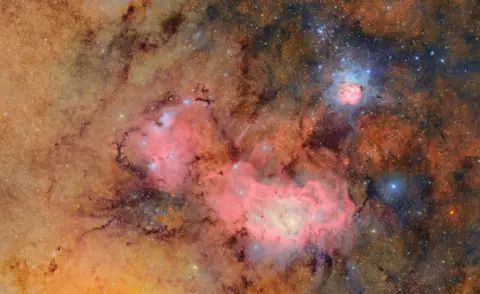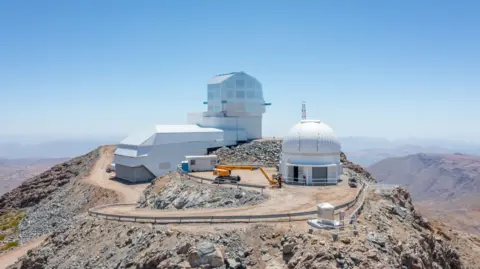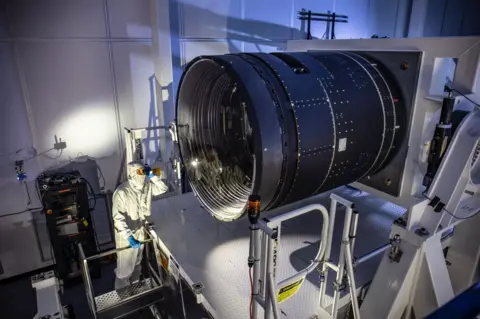Correspondent of South America
Science correspondent
 NSF-Doe Vera C. Rubin Observatory
NSF-Doe Vera C. Rubin ObservatoryA strong new telescope in Chile has published its first images, showing his unprecedented peer capability in the dark depth of the universe.
In one picture, huge colorful gas and clouds of dust goes into a region of stars 9,000 light years from the ground.
Vera C Rubin Observatory, home The most powerful digital camera in the world, promises to transform our understanding of the universe.
If there are ninth planets in our solar system, scientists say that this telescope will find it in the first year.
 Rubinobs
RubinobsIt should discover the asteroid killers in the approach to the distance of the country and maps the Milky Way. It will also answer key questions about dark matter, a mysterious substance that makes up most of our universe.
This moment once in a generation of astronomy is the beginning of a ten-year filming of the Seventh Night World.
“I personally work at this point for about 25 years. In decades we wanted to build this phenomenal facility and to do this type of survey,” says Professor Catherine Heimans, Astronomer Royal for Scotland.
The UK is a key partner in the survey and will host the data centers for processing extremely detailed shots while the telescope moves the sky that record everything in its path.
Vera Rubin could increase the number of known items in our solar system ten times.
 NSF-Doe Vera C. Rubin Observatory
NSF-Doe Vera C. Rubin ObservatoryThe BBC News visited Vero Rubin Observatory before releasing images.
Sitting at Cerro Pachon, a mountain in Chilean Andes, which hosts several observatories in private land dedicated to space research.
Very high, very dry and very dark. It’s the perfect location for watching stars.
Maintaining this darkness is Sacrosankt. A bus ride up and down with a windy road at night must be done cautiously, because headlights must not be used in full bundle.
The interior of the observatory is not different.
There is a whole engineering unit to hit a dome surrounding the telescope, which opens on the night sky, that it is dark – off of a wanderer’s lamps, which could interfere with the astronomical light that lights up the night of the sky.
Starlight is “enough” for navigation, explains the scientist of Elana Urbach Regulation.
One of the large objectives of the observatory, adds, is that “understands the history of the universe” which means that they can see weak galaxies or explosions at Supernovo, which occurred before “billions of years.”
“So, we really need very sharp pictures,” Elana says.
Every detail of the observatory shows similar precision.
 Laboratory for National Accelerator Slac
Laboratory for National Accelerator SlacIt achieves this through a unique design on three mirrors. The light enters the telescope from the night sky, hit the base mirror (8.4m diameter), is reflected in the secondary mirror (3.4m) back to the third mirror (4.8 m) before entering the camera.
Mirrors must be stored in flawless state. Even the stain of dust could change the quality of the image.
High reflection and speeds allow telescope to catch a lot of light, an active expert in the municipality, says that “really important” to watch things “really far from astronomy, means coming from previous times”.
The camera inside the telescope will recapture the night sky for ten years, every three days, for inherited space and time.
At 1.65MK 3M weighs 2,800 kg and provides a wide view of the point of view.
It will open a picture of approximately every 40 seconds, about 8-12 hours in the night, thanks to fast repositioning moving domes and a telescope carrier.
It has 3200 megapixels (67 times more than iPhone 16 Pro Camera), making it a high resolution to make a golf ball on the moon and requires a 400 Ultra HD TV screen to show one image.
“When we got the first photo here, it was a special moment,” Mr. Megias said.
“When I first started working with this project, I met someone who has been working on it since 1996. years. I was born in 1997. years. It realizes you that it is the effort of generation of astronomers.”
It will be up to hundreds of scientists around the world to analyze the course of data warning, which will be peaked around 10 million at night.
The survey will work on four areas: Mapping changes in heaven or transient facilities, forming milky way, mapping solar system and understanding dark matter or how the universe is formed.
But his greatest power lies in his constancy. They will explore the same areas over and over and every time he discovers the change, it will warn scientists.
 Rubinobs
Rubinobs“This passage is really a new unique thing … that has the potential to show us something we haven’t even thought before,” Explains Prof Heimens.
But this could help and protect us by the dangerous objects that suddenly stray near the ground, including asteroids like IR4 that scientists briefly worried early this year was on the way to collapse on our planet.
Very large cameras mirrors will help scientists discover that lighting and distortions from these facilities and find them as they accelerate through space.
“It’s transformative. It will be the biggest set of data we have ever had to look at our galaxy. It will encourage what we do many, many years,” says Professor Alis, in Durham.
It will get images to analyze how far you return the stars in the Milky Way.
Currently, most data from stars returns about 163,000 light years, but Vera Rubin could be seen back to 1.2 million light years.
Prof. Prof. He also expects to see the Star Halo’s milk road or is destroyed over time, as well as small satellite galaxies that still survive, but they fainted and find it incredibly.
It is thought that Vera Rubin is powerful enough to finally solve the long-term mystery about the existence of our planet of the solar system nine.
This item could be 700 times the distance between the earth and the sun, far above the reach of other ground telescopes.
“We will need a long time to really understand how these new beautiful observatories do. But I’m so ready for it,” says Professor Heimans.

Get our leading newsletter with all the titles you need to start the day. Sign up here.






